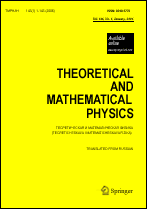|
This article is cited in 11 scientific papers (total in 11 papers)
Kulish–Sklyanin-type models: Integrability and reductions
V. S. Gerdjikovabc
a Institute of Mathematics and Informatics, Bulgarian Academy of Sciences, Sofia, Bulgaria
b Institute for Advanced Physical Studies, New Bulgarian University, Sofia, Bulgaria
c Institute for Nuclear Research and Nuclear Energy, Bulgarian Academy of Sciences, Sofia, Bulgaria
Abstract:
We start with a Riemann–Hilbert problem (RHP) related to BD.I-type symmetric spaces $SO(2r+1)/S(O(2r-2s+1)\otimes O(2s))$, $s\ge1$. We consider two RHPs: the first is formulated on the real axis $\mathbb R$ in the complex-$\lambda$ plane; the second, on $\mathbb R\oplus i\mathbb R$. The first RHP for $s=1$ allows solving the Kulish–Sklyanin (KS) model; the second RHP is related to a new type of KS model. We consider an important example of nontrivial deep reductions of the KS model and show its effect on the scattering matrix. In particular, we obtain new two-component nonlinear Schrödinger equations. Finally, using the Wronski relations, we show that the inverse scattering method for KS models can be understood as generalized Fourier transforms. We thus find a way to characterize all the fundamental properties of KS models including the hierarchy of equations and the hierarchy of their Hamiltonian structures.
Keywords:
symmetric space, multicomponent nonlinear Schrödinger equation, Lax representation, reduction group.
Received: 15.12.2016
Revised: 06.02.2017
Citation:
V. S. Gerdjikov, “Kulish–Sklyanin-type models: Integrability and reductions”, TMF, 192:2 (2017), 187–206; Theoret. and Math. Phys., 192:2 (2017), 1097–1114
Linking options:
https://www.mathnet.ru/eng/tmf9319https://doi.org/10.4213/tmf9319 https://www.mathnet.ru/eng/tmf/v192/i2/p187
|


|




 Contact us:
Contact us: Terms of Use
Terms of Use
 Registration to the website
Registration to the website Logotypes
Logotypes







 Citation in format
Citation in format 
